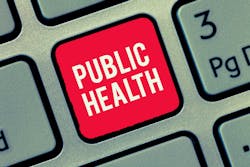A new study in Health Affairs Scholar examines hospitals’ experiences with public health reporting and their access to external electronic data during the pandemic.
The study, which includes researchers from Michigan State University, the University of Texas, Auburn University and Johns Hopkins, uses datasets from the American Hospital Association 2020 and 2022 annual IT surveys (the survey was skipped in 2021, as the 2020 survey was delayed to early 2021 due to the COVID-19 pandemic).
According to the study, which uses American Hospital Association data from 6,012 hospitals, primarily larger nonprofit teaching hospitals in urban areas, only 18 percent of hospitals found COVID-19 reporting directives to be consistent across government agencies. In addition, reporting to local governments generally appeared to be less burdensome than at the state and federal tiers:
• Twenty-six percent of hospitals reported difficulty obtaining data at the local level, versus 59 percent at the federal level and 57 percent at the state level.
• Twenty-five percent of hospitals highlighted inconsistencies in definition of reporting elements at the local level versus 53 percent at the federal level and 50 percent at the state level.
• Nineteen percent of hospitals said there were unclear reporting instructions at the local level, versus 39 percent at the federal level and 42 percent at the state level.
The study also looked at how hospitals submit data to public health agencies. According to the AHA, there are three different ways for hospitals to share data: automated mode, where electronic health records are sent directly to the public health agency; manual, where data is faxed or manually inputted into a designated portal; and mixed, which combines both automated and manual processes.
The study shows there is a clear shift in hospital data submission practices: by 2022, 23 percent of hospitals were primarily using an automated approach, up from 5 percent from 2021 (per a 2020 AHA survey), while use of the mixed approach decreased by 6 percent and use of the manual approach remained steady.
“There are significant disparities across government levels due to inconsistent requirements. This research underscores the need for standardized reporting protocols, explicit directives and a pivot from manual to automated processes,” said lead author John (Xuefeng) Jiang, Ph.D., Eli Broad Endowed Professor of Accounting at Michigan State University, in a statement. “Tackling these challenges is pivotal for ensuring prompt and reliable data, bolstering future public health responses and rejuvenating trust in public health institutions.”
“Encouraging a shift from manual to automated process should not just be a recommendation, but a public priority,” Jiang added. “Speedy, reliable data are paramount during public health emergencies, and manual processes can inhibit a rapid response.”
The research also found that hospitals with comprehensive electronic health record systems were approximately twice as likely to automate reporting of capacity and supplies data to public health agencies (21 percent versus 9 percent in hospitals without such systems) and were more effective in submitting COVID-19 vaccine-related adverse events (91 percent versus 84 percent).
Sponsored Recommendations
Sponsored Recommendations
Sponsored
Sponsored


